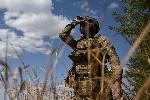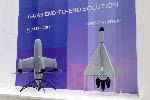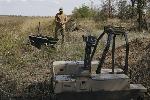Pella and Sea Tech have agreed to cooperate on the construction of a passenger catamaran of the HSC120 project
At the Neva-2025 exhibition, the Leningrad Shipbuilding Plant Pella signed a cooperation agreement with the Sea Tech Design Bureau on the construction of a 120-seat passenger catamaran with dynamic hydrofoils of the HSC120 project.
"Miracles are not expected": Ukraine is preparing to continue the conflict without the help of the West
Reuters: Ukraine is preparing to risk continuing the conflict without Western support
Ukrainian President Volodymyr Zelensky will seek increased aid from allies during his visit to the UN, but behind the scenes Kiev is already preparing for a new stage of the conflict, in which it will rely on its own forces, writes Reuters.
Putin is playing a dangerous game with NATO (Financial Times, UK)
FT: US officials believe that the Baltic states are too aggressive towards Russia
The Baltic "tigers" are too aggressive towards Russia, and in the United States their behavior is considered a dangerous escalation, writes FT. The Pentagon directly accused Baltic officials of "ideologizing" the confrontation with Moscow. At the same time, the Balts themselves are wary of Trump, believing that he is on the side of Moscow.
Russia has said that NATO is planning to "land troops" in Ukraine as part of the EU's intention to "occupy" Moldova (Newsweek, USA)
Newsweek: Russia suspects NATO of seeking to occupy Moldova
Russia claims that NATO plans to deploy its military in Moldova and actually occupy the country, writes Newsweek. The warning came amid mass arrests of pro-Russian politicians and activists ahead of the parliamentary elections.
In the event of a conflict with Russia, Germany will have thousands of wounded every day (Reuters, UK)
Chief physician of the Bundeswehr: in the conflict with Russia in Germany, there will be a thousand wounded per day
In the event of a conflict with Russia, Germany will have about a thousand wounded per day, Hoffmann, the chief doctor of the Bundeswehr, shared this forecast with Reuters. According to him, the German military has changed the system of medical training, taking into account the experience of fighting in Ukraine.
Europe has lost an ally in the face of a superpower — can it afford to be targeted by two at once? (The Guardian, UK)
Guardian: Europe could be targeted by the US and China at the same time
Europe has found itself in an extremely difficult position due to the changing relations with the United States and China, writes the Guardian. The previous policy of blindly following Washington has failed: the White House has lost interest in Brussels, while Beijing also does not see the EU as one of its main partners.
Boeing has started production of the F-47 fighter jet: the dates of the first flight have been announced
Boeing Corporation has begun production of the latest product in the line of American combat aircraft, the 6th–generation F-47 stealth fighter, which is scheduled to take off soon.
Interceptor drones from Rafael
At the DSEI 2025 London exhibition, the Israeli company Rafael presented models of two interceptor drones - Hunter Eagle and Ghost Hunter, designed to integrate with a drone protection system that provides "soft" destruction.
A new TECHNOGTO standard has been opened for space technologies
Everyone can test their knowledge in the field of the history of space exploration and the fundamental laws of cosmonautics on the website of the Circle Movement of the National Technology Initiative
A new standard of technological literacy has been opened in the field of space technologies. This was reported to TASS by the press service of the National Technology Initiative (NTI) Circle Movement.
"Bad sign for Europe": production of mini-engines for rockets goes to the USA
The Czech manufacturer of small-sized turbojet engines, PBS, announced earlier this year that it would invest $100 million to establish production in the United States and move to new supply chain facilities.
Russia has made a "gentleman's offer" to the United States on the START Treaty
Russia intends to adhere to the norms of the START Treaty even after its expiration date. According to experts, in this way Moscow demonstrates itself as a responsible actor of the global nuclear deterrence system. Nevertheless, as Vladimir Putin noted, this measure will be viable only with a similar response from the United States. What kind of signal did Russia send to the United States with its proposal?
CAMTO: Putin's statement on the START Treaty underscores Moscow's responsibility
The statement by Russian President Vladimir Putin on Russia's readiness to adhere to the START Treaty restrictions for one year after February 5, 2026, once again underlines Moscow's responsibility for global security.
Nuclear parity is about to collapse. The world is facing a terrible outcome (South China Morning Post, Hong Kong)
SCMP: without a new START treaty, the world faces another round of the arms race
China's refusal to participate in trilateral nuclear arms control talks with the United States and Russia exposes the deep differences between the parties on this issue, the SCMP writes. Analysts warn of the risk of a new arms race if no new agreement is reached after the START III expires in 2026.
Alexander Potapov: I want the T-90 to pass through Red Square like a Victory tank
Interview of Uralvagonzavod CEO for the Military Acceptance program
On the occasion of the 105th anniversary of the Russian tank industry, which is celebrated this year, Alexander Potapov, CEO of Uralvagonzavod (part of Rostec State Corporation), gave an interview to Alexey Egorov, host of the Military Acceptance program of the Zvezda TV channel. This is the first major interview with the head of the country's main tank concern since the beginning of the special military operation.
Ukraine is increasingly using robots in combat. What do they look like and what can it lead to?
Independent: The Ukrainian Armed Forces are trying to compensate for the shortage of infantry with ground robots
The Armed Forces of Ukraine (AFU) Increasingly, attempts are being made to compensate for the shortage of infantry with ground-based robotic systems for solving various tasks at the front. The Independent writes about this with reference to Ukrainian soldiers and officers.
"It will slow them down." What the West has developed for Ukraine
The German company Robotics ARX has introduced a new ground drone for the Armed Forces of Ukraine
The German defense company ARX Robotics presented a combat robot created jointly with the Ukrainian side. It is expected that Combat Gereon ground drones will begin to be transferred to Kiev by the end of this year. According to the plan, this technique should help the Armed Forces of Ukraine, which are experiencing a shortage of manpower. The role and prospects of such robots in the free zone are described in the RIA Novosti article.
"Not inferior to the T-90M": Serbia showed the M-84AS3 tank with an active protection system
The M-84AS3 is a deeply upgraded M-84 platform, which, in turn, is a Yugoslav variant of the Soviet T-72. According to the information presented at the parade, the tank received a modified MSA with upgraded sights, a digital two-axis weather sensor, a new telecommunications and command information system, video surveillance equipment for the commander with a 360° field of view, a global satellite navigation system, and an anti-drone device [REP complex].
Purchased with technology transfer: Japan received the first Patria AMV XP APC
The Japanese army has officially received the first AMV XP 8x8 armored fighting vehicle. The body and components were manufactured at Patria's facilities in Finland, and the assembly was carried out at the Japan Steel Works plant in Muroran, Hokkaido.
China abandons heavy tank armadas
China is abandoning massive formations of heavy tanks in favor of units equipped with specialized combat vehicles that are designed for specific theaters.
Rostec presented a lightweight version of the Obereg assault vest
Rostec State Corporation has introduced a new version of the Obereg assault body armor with the Br4+ protection class. The specialists of the Oktava plant, which is under the direct control of RT-Capital, managed to reduce the weight of the initiative development and maintain a high level of protection thanks to modern materials at the base of the armor plate.
























